Hydrophobic Forces Are Relevant to Bacteria-Nanoparticle Interactions: Pseudomonas putida Capture Efficiency by Using Arginine, Cysteine or Oxalate Wrapped Magnetic Nanoparticles
Abstract
:1. Introduction
2. Materials and Methods
2.1. Reagents and Microbial Culture
2.2. Synthesis of Oxalate Coated Fe3O4 NPs (Fe3O4@Oxa)
2.3. Synthesis of Amino Acids Coated Fe3O4 NPs from Fe3O4@Oxa
2.4. Characterization Methods
2.5. Bacteria Capture Experiments
3. Results
3.1. Characterization of Fe3O4@Oxa, Fe3O4@Arg and Fe3O4@Cys
3.2. Bacteria Capture Experiments
4. Discussion
5. Conclusions
Supplementary Materials
Author Contributions
Funding
Acknowledgments
Conflicts of Interest
References
- Roger, J.; Pons, J.N.; Massart, R.; Halbreich, A.; Bacri, J.C. Some biomedical applications of ferrofluids. Eur. Phys. J. Appl. Phys. 1999, 5, 321–325. [Google Scholar] [CrossRef]
- Sun, S.; Murray, C.B.; Weller, D.; Folks, L.; Moser, A. Monodisperse FePt nanoparticles and ferromagnetic FePt nanocrystal superlattices. Science 2000, 287, 1989–1992. [Google Scholar] [CrossRef] [PubMed]
- Miller, M.M.; Prinz, G.A.; Cheng, S.F.; Bounnak, S. Detection of a micron-sized magnetic sphere using a ring-shaped anisotropic magnetoresistance-based sensor: A model for a magnetoresistance-based biosensor. Appl. Phys. Lett. 2002, 81, 2211–2213. [Google Scholar] [CrossRef]
- Chourpa, I.; Douziech-Eyrolles, I.; Ngaboni-Okassa, L.; Fouquenet, J.F.; Cohen-Jonathan, S.; Soucé, M.; Marchis, H.; Dubois, P. Molecular composition of iron oxide nanoparticles, precursors for magnetic drug targeting, as characterized by confocal Raman microspectroscopy. Analyst 2005, 130, 1395–1403. [Google Scholar] [CrossRef] [PubMed]
- Boutry, S.; Laurent, S.; Elst, L.V.; Muller, R.N. Specific E-selectin targeting with a superparamagnetic MRI contrast agent. Contrast Media Mol. Imaging 2006, 1, 15–22. [Google Scholar] [CrossRef] [PubMed]
- Corot, C.; Robert, P.; Idée, J.M.; Port, M. Recent advances in iron oxide nanocrystal technology for medical imaging. Adv. Drug Deliv. Rev. 2006, 58, 1471–1504. [Google Scholar] [CrossRef] [PubMed]
- Sambucetti, C. Magnetic ink for jet printing. IEEE Trans. Med. Imaging 1980, 16, 364–367. [Google Scholar] [CrossRef]
- Gupta, A.K.; Wells, S. Surface-modified superparamagnetic nanoparticles for drug delivery: Preparation, characterization, and cytotoxicity studies. IEEE Trans. Nanotechnol. 2004, 3, 66–73. [Google Scholar] [CrossRef]
- Kim, D.K.; Zhang, Y.; Voit, W.; Rao, K.V.; Muhammed, M.J. Synthesis and characterization of surfactant-coated superparamagnetic monodispersed iron oxide nanoparticles. J. Magn. Magn. Mater. 2001, 225, 30–36. [Google Scholar] [CrossRef]
- Jolivet, J.P. Metal Oxide Chemistry and Synthesis: From Solution to Solid State; Wiley and Sons Ltd.: West Sussex, UK, 2000. [Google Scholar]
- Vayssières, L.; Chanéac, C.; Tronc, E.; Jolivet, J.P. Size tailoring of magnetite particles formed by aqueous precipitation: An example of thermodynamic stability of nanometric oxide particles. J. Colloid Interface Sci. 1998, 205, 205–212. [Google Scholar] [CrossRef] [PubMed]
- Tartaj, P.; Morales, M.P.; Veintemilla-Verdaguer, S.; Gonzalez-Carreno, T.; Serna, C.J. Synthesis, properties and biomedical applications of magnetic nanoparticles. In Handbook of Magnetic Materials; Buschow, K.H.J., Ed.; Elsevier: Amsterdam, The Neverthelands, 2006; Volume 16, pp. 403–482. [Google Scholar]
- Dunlop, D.J.; Özdemir, Ö. Rock Magnetism: Fundamentals and Frontiers; Cambridge University Press: Cambridge, UK, 1997. [Google Scholar]
- Vincent, B.; Edwards, J.; Emment, S.; Jones, A. Depletion flocculation in dispersions of sterically-stabilised particles (‘soft spheres’). Colloids Surf. 1986, 18, 261–281. [Google Scholar] [CrossRef]
- Laurent, S.; Forge, D.; Port, M.; Roch, A.; Robic, C.; Vander Elst, L.; Muller, R.N. Magnetic iron oxide nanoparticles: Synthesis, stabilization, vectorization, physicochemical characterizations, and biological applications. Chem. Rev. 2008, 108, 2064–2110. [Google Scholar] [CrossRef] [PubMed]
- Cornell, R.M.; Schwetmann, U. The Iron Oxides: Structure, Properties, Reactions, Occurrences and Uses, 2nd ed.; Wiley-VCH: Weinheim, Germany, 2006. [Google Scholar]
- Massart, R.; Dubois, E.; Cabuil, V.; Hasmonay, E. Preparation and properties of monodisperse magnetic fluids. J. Magn. Magn. Mater. 1995, 149, 1–5. [Google Scholar] [CrossRef]
- Schwaminger, S.P.; García, P.F.; Merck, G.K.; Bodensteiner, F.A.; Heissler, S.; Günther, S.; Berensmeier, S. Nature of interactions of amino acids with bare magnetite nanoparticles. J. Phys. Chem. C 2015, 119, 23032–23041. [Google Scholar] [CrossRef]
- Koo, H.; Allan, R.N.; Howlin, R.P.; Hall-Stoodley, L.; Stoodley, P. Targeting microbial biofilms: Current and prospective therapeutic strategies. Nat. Rev. Microbiol. 2017, 15, 740–755. [Google Scholar] [CrossRef] [PubMed]
- Kumar, M.; Curtis, A.; Hoskins, C. Application of nanoparticle technologies in the combat against anti-microbial resistance. Pharmaceutics 2018, 10, 11. [Google Scholar] [CrossRef] [PubMed]
- Jin, Y.; Liu, F.; Shan, C.; Tong, M.; Hou, Y. Efficient bacterial capture with amino acid modified magnetic nanoparticles. Water Res. 2014, 50, 124–134. [Google Scholar] [CrossRef] [PubMed]
- Abenojar, E.C.; Wickramasinghe, S.; Ju, M.; Uppaluri, S.; Klika, A.; George, J.; Barsoum, W.; Frangiamore, S.J.; Higuera-Rueda, C.A.; Samia, A.C.S. Magnetic glycol chitin-based hydrogel nanocomposite for combined thermal and D-amino-acid-assisted biofilm disruption. ACS Infect. Dis. 2018, 10, 11. [Google Scholar] [CrossRef] [PubMed]
- Kallay, N.; Matijevic, E. Adsorption at solid/solution interfaces. 1. Interpretation of surface complexation of oxalic and citric acids with hematite. Langmuir 1985, 1, 195–201. [Google Scholar] [CrossRef]
- Tie, S.L.; Lin, Y.Q.; Lee, H.C.; Bae, Y.S.; Lee, C.H. Amino acid-coated nano-sized magnetite particles prepared by two-step transformation. Colloids Surf. A 2006, 273, 75–83. [Google Scholar] [CrossRef]
- Cametti, C.; Codastefano, P.; Tartaglia, P. Aggregation kinetics in model colloidal systems: A light scattering study. J. Colloid Interface Sci. 1989, 131, 409–422. [Google Scholar] [CrossRef]
- Bromberg, L.; Chang, E.P.; Hatton, T.A.; Concheiro, A.; Magariños, B.; Alvarez-Lorenzo, C. Bactericidal core-shell paramagnetic nanoparticles functionalized with poly(hexamethylene biguanide). Langmuir 2011, 27, 420–429. [Google Scholar] [CrossRef] [PubMed]
- Vieira, A.P.; Berndt, G.; de Souza, I.G., Jr.; Di Mauro, E.; Paesano, A., Jr.; de Santana, H. Adsorption of cysteine on hematite, magnetite and ferrihydrite: FT-IR, Mössbauer, EPR spectroscopy and X-ray diffractometry studies. Amino Acids 2011, 40, 205–214. [Google Scholar] [CrossRef] [PubMed]
- Ünal, B.; Durmus, Z.; Baykal, A.; Sözeri, H.; Toprak, M.S.; Alpsoy, L. l-Histidine coated iron oxide nanoparticles: Synthesis, structural and conductivity characterization. J. Alloys Compd. 2010, 505, 172–178. [Google Scholar] [CrossRef]
- Bastian, E.J.; Martin, R.B. Disulfide vibrational spectra in the sulfur-sulfur and carbon-sulfur stretching region. J. Phys. Chem. 1973, 77, 1129–1133. [Google Scholar] [CrossRef]
- La, B.H.; Yeh, C.C.; Chen, D.H. Surface modification of iron oxide nanoparticles with polyarginine as a highly positively charged magnetic nano-adsorbent for fast and effective recovery of acid proteins. Process. Biochem. 2012, 47, 799–805. [Google Scholar] [CrossRef]
- Sangeetha, J.; Philip, J. Synthesis, characterization and antimicrobial property of Fe3O4-Cys-HNQ nanocomplex, with l-cysteine molecule as a linker. RSC Adv. 2013, 3, 8047–8057. [Google Scholar] [CrossRef]
- Wejrzanowski, T.; Pielaszek, R.; Opalinska, A.; Matysiak, H.; Lojkowski, W.; Kurzydlowski, K.J. Quantitative methods for nanopowders characterization. Appl. Surf. Sci. 2006, 253, 204–208. [Google Scholar] [CrossRef]
- Huang, Y.F.; Wang, Y.F.; Yan, X.P. Amine-functionalized magnetic nanoparticles for rapid capture and removal of bacterial pathogens. Environ. Sci. Technol. 2010, 44, 7908–7913. [Google Scholar] [CrossRef] [PubMed]
- Honda, H.; Kawabe, A.; Shinkai, M.; Kobayashi, T. Development of chitosan-conjugated magnetite for magnetic cell separation. J. Ferment. Bioeng. 1998, 86, 191–196. [Google Scholar] [CrossRef]
- Xu, Z.Z.; Wang, C.C.; Yang, W.L.; Deng, Y.H.; Fu, S.K. Encapsulation of nanosized magnetic iron oxide by polyacrylamide via inverse miniemulsion polymerization. J. Magn. Magn. Mater. 2004, 277, 136–143. [Google Scholar] [CrossRef]
- Angermann, A.; Töpfer, J. Synthesis of magnetite nanoparticles by thermal decomposition of ferrous oxalate dihydrate. J. Mater. Sci. 2008, 43, 5123–5130. [Google Scholar] [CrossRef]
- Smolensky, E.D.; Park, H.Y.; Zhou, Y.; Rolla, G.A.; Marjańska, M.; Botta, M.; Pierre, V.C. Scaling laws at the nano size: The effect of particle size and shape on the magnetism and relaxivity of iron oxide nanoparticle contrast agents. J. Mater. Chem. B 2013, 1, 2818–2828. [Google Scholar] [CrossRef] [PubMed]
- Chen, G.; Li, Z.; Wang, X.; Xie, L.; Qi, Q.; Fang, W. Preparation of CTAB-loaded magnetic nanospheres for rapid bacterial capture and decontamination. Mater. Lett. 2014, 134, 290–294. [Google Scholar] [CrossRef]
- El-Boubbou, K.; Gruden, C.; Huang, X. Magnetic glyco-nanoparticles: A unique tool for rapid pathogen detection, decontamination, and strain differentiation. J. Am. Chem. Soc. 2007, 129, 13392–13393. [Google Scholar] [CrossRef] [PubMed]
- Ranmadugala, D.; Ebrahiminezhad, A.; Manley-Harris, M.; Ghasemi, Y.; Berenjian, A. Magnetic immobilization of bacteria using iron oxide nanoparticles. Biotechnol. Lett. 2018, 40, 237–248. [Google Scholar] [CrossRef] [PubMed]
- Van Loosdrecht, M.C.; Lyklema, J.; Norde, W.; Schraa, G.; Zehnder, A.J. Electrophoretic mobility and hydrophobicity as a measured to predict the initial steps of bacterial adhesion. Appl. Environ. Microb. 1987, 53, 1898–1901. [Google Scholar]
- Yang, X.; Dang, Y.; Lou, J.; Shao, H.; Jiang, X. D-alanyl-D-alanine-modified gold nanoparticles form a broad-spectrum sensor for bacteria. Theranostics 2018, 8, 1449–1457. [Google Scholar] [CrossRef] [PubMed]
- Geoghegan, M.; Andrews, J.S.; Biggs, C.A.; Eboigbodin, K.E.; Elliott, D.R.; Rolfe, S.; Scholes, J.; Ojeda, J.J. The polymer physics and chemistry of microbial cell attachment and adhesion. Faraday Discuss. 2008, 139, 85–103. [Google Scholar] [CrossRef] [PubMed]
- Yousefi Rad, A.; Ayhan, H.; Pişkin, E. Adhesion of different bacterial strains to low-temperature plasma-treated sutures. J. Biomed. Mater. Res. 1998, 41, 349–358. [Google Scholar] [CrossRef]
- Roosjen, A.; Busscher, H.J.; Norde, W.H.; van der Mei, C. Bacterial factors influencing adhesion of Pseudomonas aeruginosa strains to a poly(ethylene oxide) brush. Microbiology 2006, 152, 2673–2682. [Google Scholar] [CrossRef] [PubMed]
- Xue, J.; BinAhmed, S.; Wang, Z.; Karp, N.G.; Stottrup, B.L.; Romero-Vargas Castrillón, S. Bacterial adhesion to graphene oxide (GO)-functionalized interfaces is determined by hydrophobicity and GO sheet spatial orientation. Environ. Sci. Technol. Lett. 2017, 5, 14–19. [Google Scholar] [CrossRef]
- Zhan, S.; Zhu, D.; Ma, S.; Yu, W.; Jia, Y.; Li, Y. Highly efficient removal of pathogenic bacteria with magnetic graphene composite. ACS Appl. Mater. Interfaces 2015, 7, 4290–4298. [Google Scholar] [CrossRef] [PubMed]
- Huang, X.; Xiong, Y.; Lu, L.; Liu, J.; Peng, K. Manipulation of surface hydrophobicity and charge of demulsifying bacteria using functional magnetic nanoparticles: A mechanistic study of demulsification performance. Energy Fuels 2017, 31, 3295–3304. [Google Scholar] [CrossRef]
- Darabdhara, G.; Boruah, P.K.; Hussain, N.; Borthakur, P.; Sharma, B.; Sengupta, P.; Das, M.R. Magnetic nanoparticles towards efficient adsorption of Gram positive and Gram negative bacteria: An investigation of adsorption parameters and interaction mechanism. Colloids Surf. A Physicochem. Eng. Asp. 2017, 516, 161–170. [Google Scholar] [CrossRef]
- Cserháti, T.; Szögyi, M. Role of hydrophobic and hydrophilic forces in peptide-protein interaction: New advances. Peptides 1995, 16, 165–173. [Google Scholar] [CrossRef]
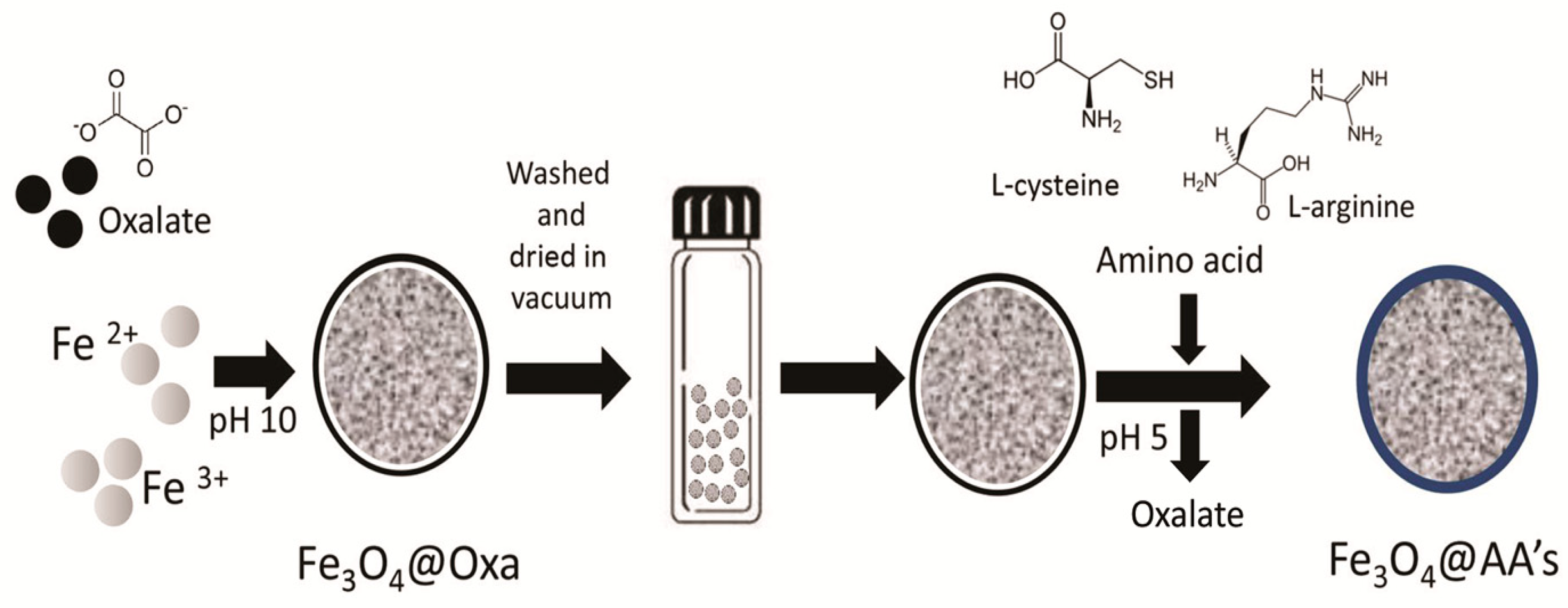
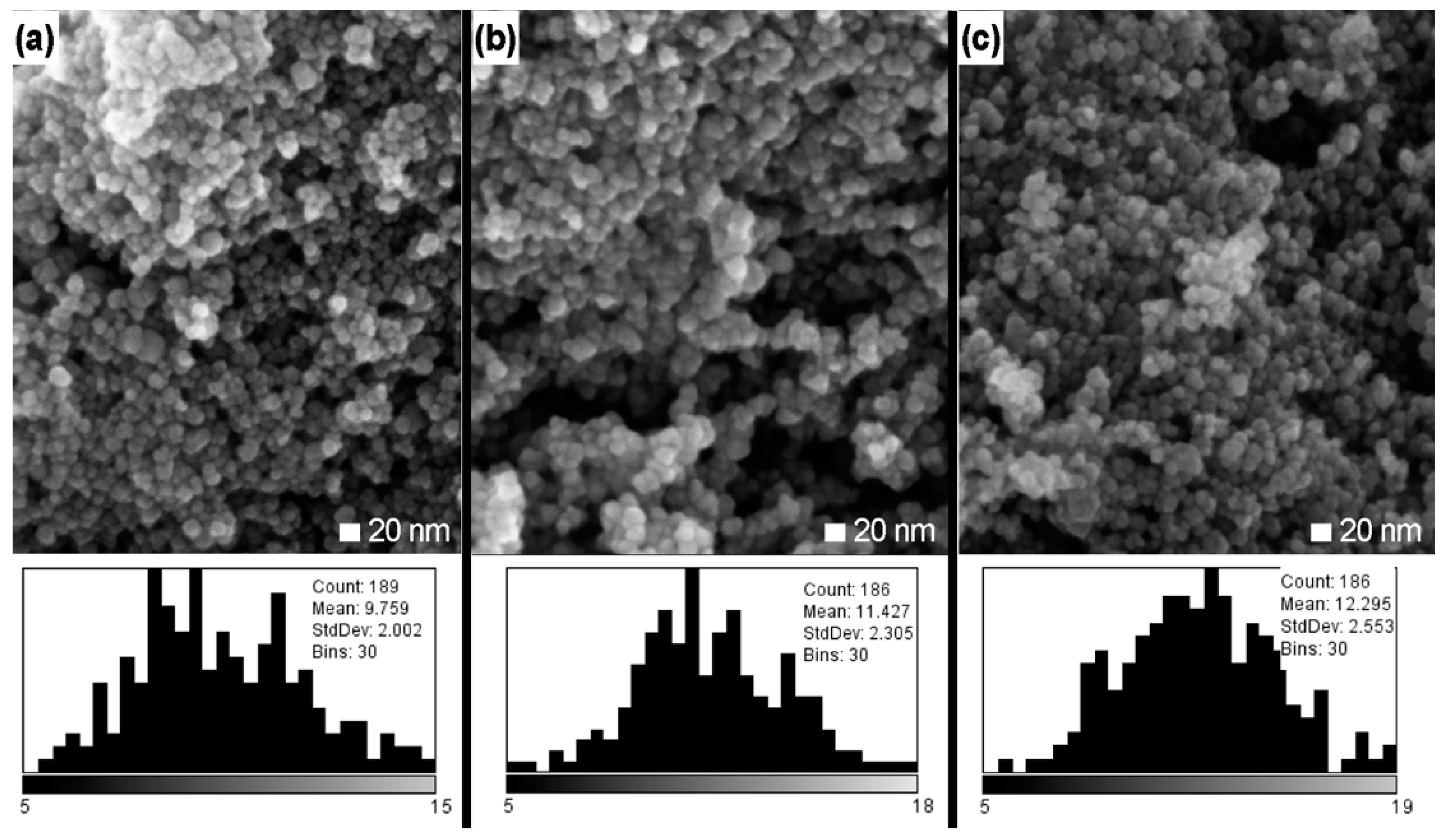
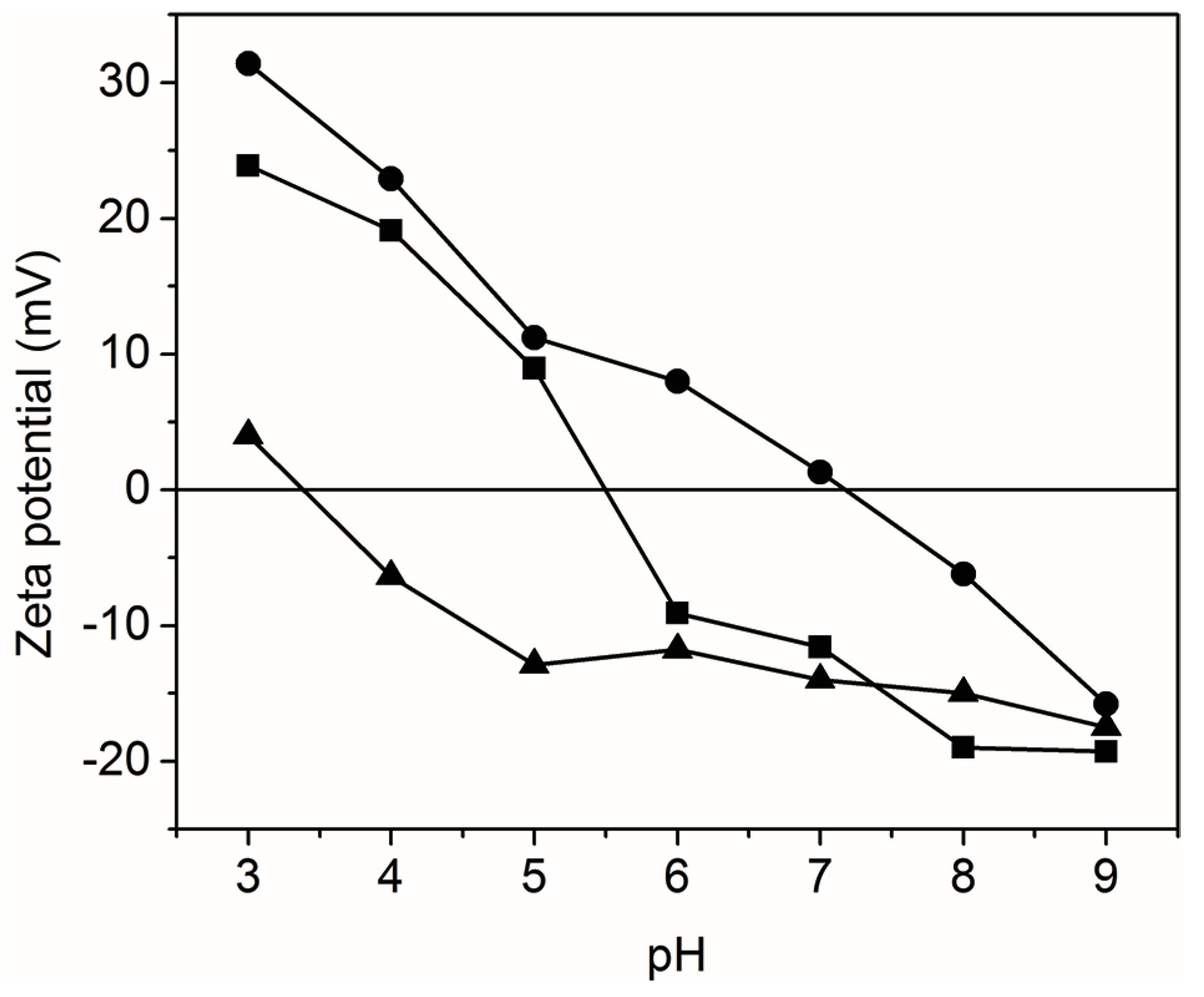

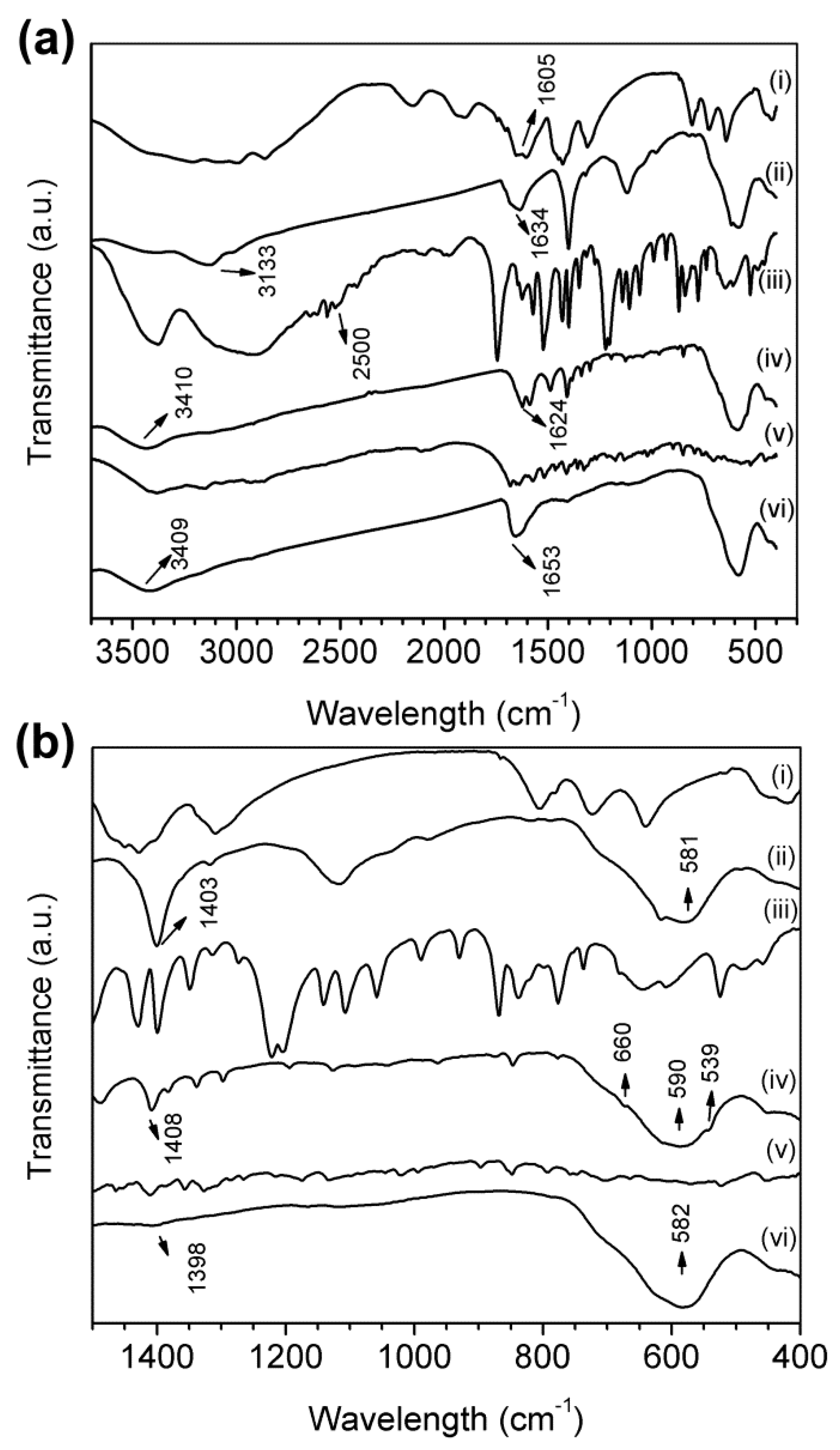

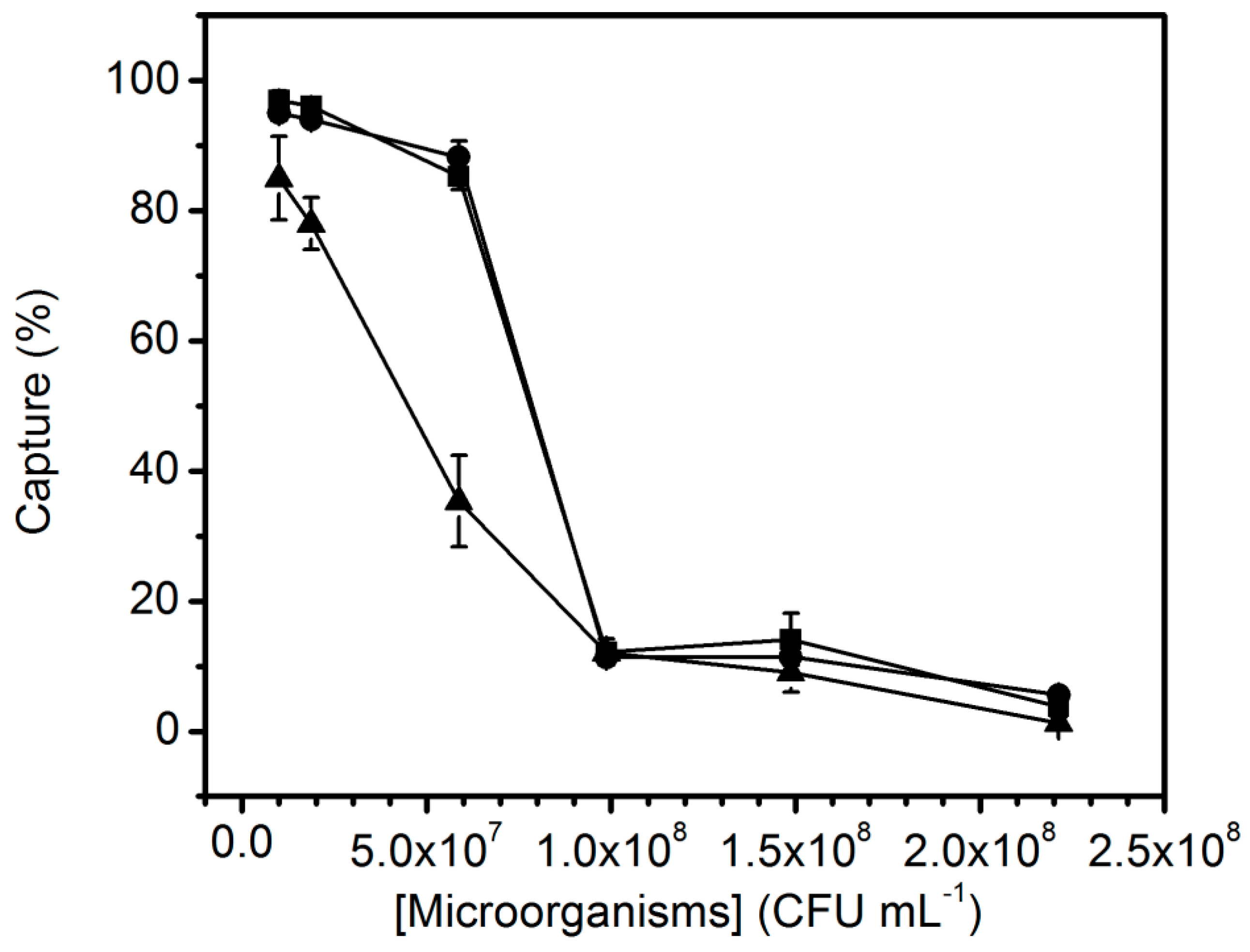
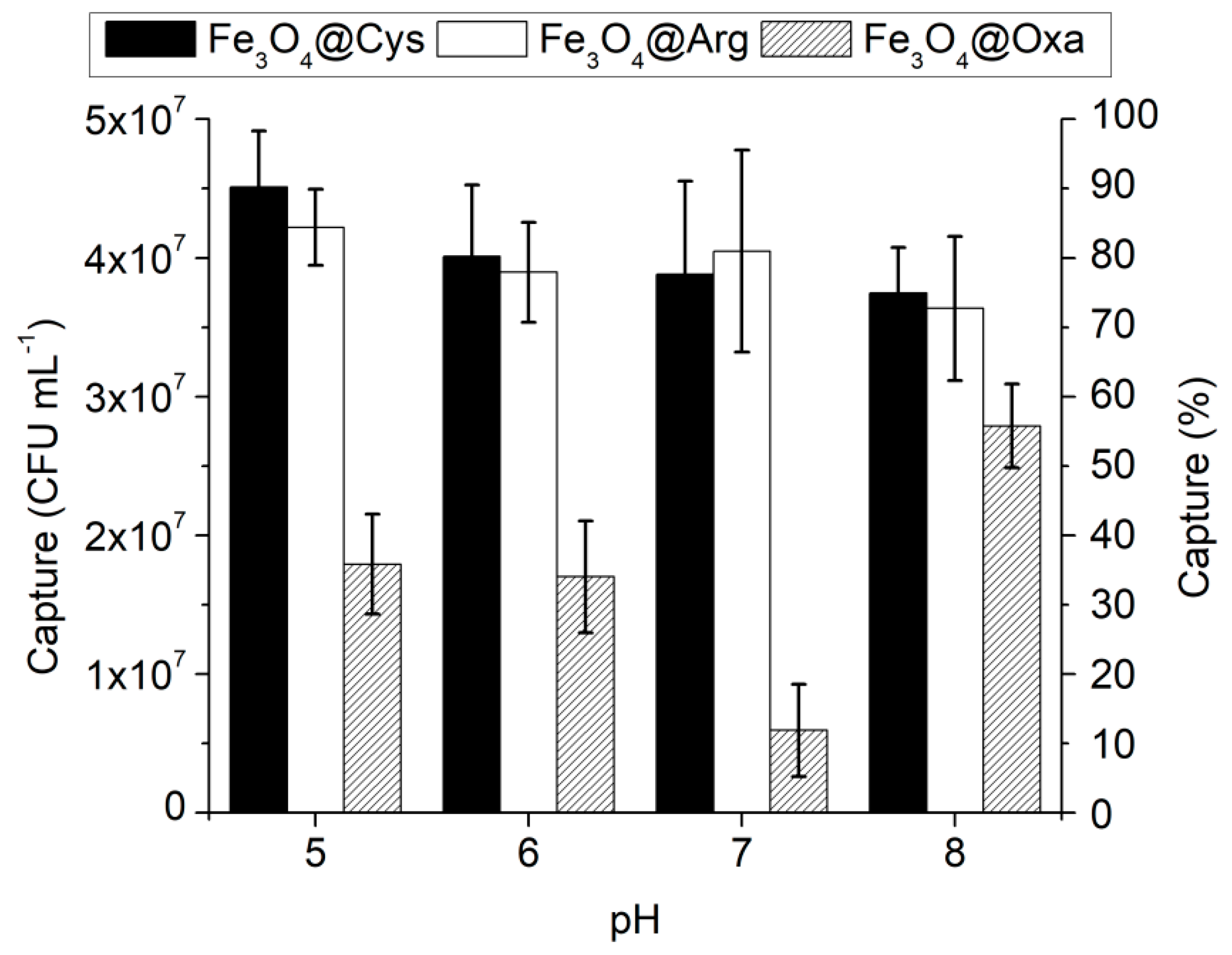
| NPs | C (%) | O (%) | Fe (%) | N (%) | S (%) |
|---|---|---|---|---|---|
| Fe3O4@Oxa | 8.4 | 58.7 | 33.53 | - | - |
| Fe3O4@Cys | 30.54 | 39.6 | 11.09 | 8.61 | 10.16 |
| Fe3O4@Arg | 10.28 | 51.18 | 31.62 | 6.92 | - |
| NPs | Size (nm) | Capture Media (pH) | V (mL) | NPs (mg mL−1) | CFU mL−1 before Incubation | Incubation (min) | Capture Efficiency (%) | Ref. |
|---|---|---|---|---|---|---|---|---|
| Fe3O4@Oxa | 9.8 ± 2.0 | CBS (5) | 2 | 1 | 1 × 107 (P. putida) | 30 | 85 | This work |
| Fe3O4@Arg | 11.4 ± 2.3 | CBS (5) | 2 | 1 | 1 × 107 (P. putida) | 30 | 95 | This work |
| Fe3O4@Cys | 12.3 ± 2.5 | CBS (5) | 2 | 1 | 1 × 107 (P. putida) | 30 | 97 | This work |
| Fe3O4@mSiO2/CTAB | 150 | PBS (ns) | 2 | 0.2 | ≈107 (B. subtillis or E. coli) | 10 | 98 | [38] |
| Fe3O4@Arg | 10 | H2O (6) | 5 | 0.8 | 1.5 × 107 (E. coli) | 30 | 97 | [21] |
| Fe3O4@Man | 10 | PBS (ns) | 1 | 2 | 1.5 × 106 (E. coli) | 45 | 83.5 | [39] |
| Fe3O4@AF | ns | PBS (7) | 5 | 1 | ns, OD600nm = 1 (E. coli) | 1 | 97 | [33] |
© 2018 by the authors. Licensee MDPI, Basel, Switzerland. This article is an open access article distributed under the terms and conditions of the Creative Commons Attribution (CC BY) license (http://creativecommons.org/licenses/by/4.0/).
Share and Cite
Figueredo, F.; Saavedra, A.; Cortón, E.; Diz, V.E. Hydrophobic Forces Are Relevant to Bacteria-Nanoparticle Interactions: Pseudomonas putida Capture Efficiency by Using Arginine, Cysteine or Oxalate Wrapped Magnetic Nanoparticles. Colloids Interfaces 2018, 2, 29. https://doi.org/10.3390/colloids2030029
Figueredo F, Saavedra A, Cortón E, Diz VE. Hydrophobic Forces Are Relevant to Bacteria-Nanoparticle Interactions: Pseudomonas putida Capture Efficiency by Using Arginine, Cysteine or Oxalate Wrapped Magnetic Nanoparticles. Colloids and Interfaces. 2018; 2(3):29. https://doi.org/10.3390/colloids2030029
Chicago/Turabian StyleFigueredo, Federico, Albert Saavedra, Eduardo Cortón, and Virginia E. Diz. 2018. "Hydrophobic Forces Are Relevant to Bacteria-Nanoparticle Interactions: Pseudomonas putida Capture Efficiency by Using Arginine, Cysteine or Oxalate Wrapped Magnetic Nanoparticles" Colloids and Interfaces 2, no. 3: 29. https://doi.org/10.3390/colloids2030029





